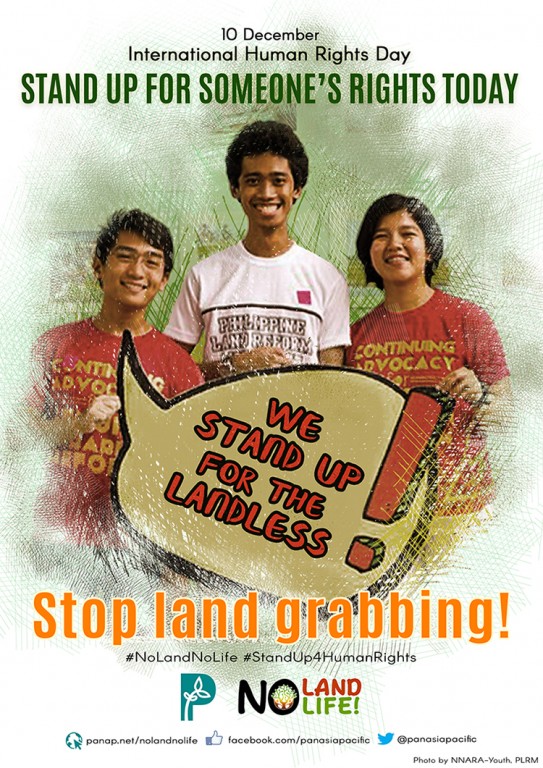PENANG, Malaysia – Advocacy group PAN Asia Pacific (PANAP) today said that the attacks against defenders of the people’s right to land and resources continued to intensify and worsened to even more alarming levels in 2016.
An average of almost 16 farmers, indigenous people, and advocates of the people’s right to land were being killed every month this year – or three times the average in 2015 – in Asia Pacific and other regions, the group claimed.
PANAP made the statement as the world marks the International Human Rights Day on 10 December.
“The sharp rise in the number of killings and the overall increase in human rights atrocities against poor rural communities embroiled in land conflicts is alarming, to say the least. It underscores the impunity with which these political killings and brutalities are being committed,” said Ms. Sarojeni Rengam, PANAP executive director.
In 2015, PANAP monitored 61 victims of killings that ballooned to 171 from January to November 2016. There were also 32 victims of frustrated killings, adding up to the 54 victims last year. Meanwhile, the victims of arbitrary detention from January to November this year numbered 118 and trumped up charges, 14; in 2015, the figures were 127 and 82 victims, respectively.
The trend in worsening killings noted by PANAP is consistent with the data compiled by UK-based campaign group Global Witness, which has been tracking the killings of environmental and land activists since 2002. Global Witness reported that in the past 13 years there have been 1,209 killings of land and environmental activists worldwide. The trend has worsened with the average killings per year more than doubling from 55 annually in 2002 to 2009 to 128 in 2010 to 2015. Last year was the worst year, said Global Witness, with killings recorded at 185.
“These human rights violations represent double repression. The people’s collective rights to own or control their land and resources for livelihood and cultural needs are wantonly being violated by corporations and governments. When these people rightfully resist and defend their rights, they are harassed and in many cases, killed,” Rengam said.
PANAP’s data are based on its Land & Rights (L&R) Watch initiative, which monitors various cases of human rights violations against farmers, indigenous people, and advocates of the right to land and resources. L&R Watch started compiling data based on online reports and reports from PANAP partners in the region in January 2015 and is an ongoing effort. The latest data are as of end-November 2016.
Land grabs to intensify
PANAP expressed concern that the atrocities will not just continue but will even further intensify as recent global and regional trends and developments are fanning social conflicts in the countryside between rural communities and governments and profit-seeking corporations and local elites. The onslaught to monopolize land and resources for private profits – and massively displace peasant and indigenous communities, in the process – has intensified more than ever.
“One particular trend that should be closely watched in relation to our campaign against land grabbing in the region is the steady rise of China as an economic giant and the consequent surge in its appetite for more land and resources to feed its economy,” said Rengam.
PANAP noted that China has been leading the efforts to push for more trade and investment liberalization through its Regional Comprehensive Economic Partnership (RCEP), especially with the Trans-Pacific Partnership (TPP) expected to slow down under a Trump administration in the US.
China is also aggressively funding infrastructure development projects that stir land conflicts such as its ambitious trillion-dollar modern “Silk Road” covering about 60 countries. Public-private partnership (PPP) to build infrastructure that lead to massive displacement of rural folks will get a boost as well with the recently established China-led Asian Infrastructure Investment Bank (AIIB), along with the usual PPP funders like the World Bank and Asian Development Bank (ADB).
In a recent meeting with peasant and indigenous leaders and campaigners from Cambodia, India, Indonesia, Malaysia, Pakistan, the Philippines and Sri Lanka, PANAP learned of the increasing Chinese presence or involvement in various development projects such as in economic zones, plantations, eco-tourism, and others that displaced or are feared to displace numerous rural communities.
 Greater vigilance, resistance and support
Greater vigilance, resistance and support
“Now more than ever, we need greater vigilance and resistance to protect and advance the people’s collective right to land and resources. We must generate broader support for the peasant and indigenous communities that are fighting back as those who want to take away their farm and ancestral lands for profit become more and bigger,” Rengam emphasized.
The PANAP official pointed out that while China is emerging as a new formidable foe, the usual powerful forces and players remain such as the local elite and corrupt politicians, and the corporations and financial institutions from the West.
“It’s good that the theme for this year (of the International Human Rights Day) is to stand up for someone’s rights. It’s a call for everyone who believe in what is just and democratic to stand up for the landless and join the movement to defend the people’s rights,” said Rengam. ###
Reference: Ms. Sarojeni Rengam, Executive Director, nolandnolife@panap.net








Discussion about this post